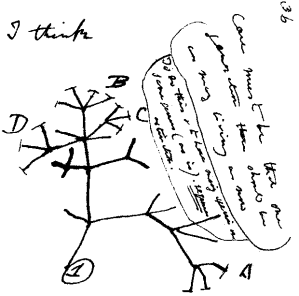February 12th, 2016 is Charles Darwin’s 207th birthday. Charles also happened to share the exact same date of birth with Abraham Lincoln – so happy birthday Mr. Lincoln, as well! Since this blog is dedicated to science, with a special emphasis on evolution, and in fact, has the name Darwin in the title, I want to be sure to honor our dear Mr. Darwin properly.
There are Darwin Day celebrations planned in the USA and around the world, but no ‘Official Darwin Day’ is recognized nationally. That could change as some efforts are being made to make it official. In fact, this year the Governor of Delaware declared an official Darwin Day in his state. In some cities there are lectures or parties to celebrate. The Center for Inquiry has a take action page, where you can send your name in a letter to members of congress to express the importance of creating a Darwin’s Day for public education of science.
Charles Darwin’s theory of evolution was the beginning of modern biological science. As the Russian evolutionary biologist Theodosius Dobzhansky is quoted as saying, “Nothing in biology makes sense except in the light of evolution”. Evolution is the thread that binds all of biology together. Every aspect of biology, from molecular genetics, embryology, comparative anatomy, populations and ecosystems all “make sense in the light of evolution”.

Darwin’s theory was a realization of origin from common decent. Evolution does not address the emergence of life from non-biological origins, but does an excellent job explaining the illusion of design seen in the complex structures of the living world. Of course, Darwin realized that the illusion was the product of natural selection working on variations in living things. Darwin had no idea about genetics, DNA, mutations, and so on, but as those fields of biology developed they only reinforced Darwin’s big idea. It could easily have been otherwise. If evolution by natural selection was not how the world worked, then molecular genetics, phylogenetic, developmental biology, and so on would not have provided additional support to a 150 year old theory. Yet, all these modern sciences fit in perfectly, continuing to build on the original theory. Even without the fossil record modern biology would still point the way to evolution. By the way, the fossil record also supports evolution, and has only become more robust during the last 150 years as many more fossil species have now been discovered.

I’m sure Darwin would have been delighted to learn about genes, how new mutations arise by damage due to radiation, chemical mutagens, or simply errors in the normal process of DNA synthesis. He would have loved to see how the genome is cluttered with the remains of dead viruses, pseudogenes, copying errors that we have been copying and passing down to our children for geological eons. And he would have certainly understood that we can see our degree of relatedness to any living species on the planet by looking at, not just the working genes and how closely they match to us, but also these dead viruses and pseudogenes.

Darwin’s voyage on the H.M.S Beagle remains one of the most exciting and most epic expeditions of discovery in history – certainly one of the most productive, since it resulted in much of the data Darwin needed to formulate his theory over the next several decades. Darwin was an amazing naturalist and keen observer. There is hardly any area of natural science of his time that he didn’t seem to make some meaningful contributions. Not just in biology but in geology, as well.
So this Darwin’s day I plan to celebrate at home with my family. Perhaps have a piece of Common Decent Cake or Evolution Pie, learn something new I didn’t know about evolution, and honor our Dear Mr. Darwin. Let me know how you plan to celebrate.
Other Reading:
- Darwin Day: Wikipedia
- Natural Selection: Wikipedia
- Youtube. Climbing Mount Improbable. Lecture by Richard Dawkins.
- OxoG is how radiation turns your own water against you. Darwin’s Kidneys blog
- Cytosine Deamination. Darwin’s Kidneys blog. (another mechanism of mutation).
- Another Clever Mesign by Mother Nature. Darwin’s Kidneys blog. New word mesign to differentiate apparent design in nature from when we mean a designed object.
- How our ancestors promiscuous genes became more discriminating. ZME Science. Feb. 9, 2016. Article on how gene families arise by gene duplications.

